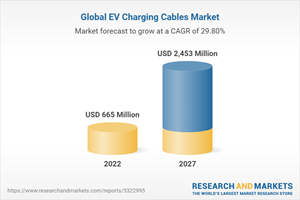EV Charging Cables Global Market Report 2022-2027: Government Policies & Subsidies to Support Faster Setup of EV Charging Stations to Drive Growth

Global EV Charging Cables Market

Dublin, June 30, 2022 (GLOBE NEWSWIRE) -- The "EV Charging Cables Market by Power Supply (AC and DC), Application (Private Charging and Public Charging), Length (2-5 Meters, 6-10 Meters, and >10 Meters), Shape (Straight and Coiled), Mode, Charging Level, Diameter and Region - Global Forecast to 2027" report has been added to ResearchAndMarkets.com's offering.
The global EV charging cables market is projected to grow at a CAGR of 29.8%, to reach USD 2,453 million by 2027 from an estimated USD 665 million in 2022. Factors such as rapidly developing EV infrastructure, rising EV sales worldwide, and government support for the overall EV ecosystem are expected to support the EV charging cables market growth.
Increasing concerns about the environment along with rapid improvements in battery and charging technologies have contributed to the growing popularity of electric vehicles. Similarly, improving vehicle range is further supporting the demand for electric vehicles across the world. Further, faster-charging technology has reduced the range anxiety among the people.
Earlier, electric vehicle batteries took a long time to charge completely, but level 3 chargers can now charge a vehicle in less than an hour and enable the vehicle to run for more than 200 km. The increasing demand for zero-emission vehicles is also likely to boost electric vehicle sales, which, in turn, would accentuate the need for charging cables.
Mode 1 & 2 segment is estimated to be the largest market during the forecast period
The mode 1 & 2 segments is expected to lead the market during the forecast period. Mode 1 charging cables refer to domestic charging from a normal power socket at homes with a simple charging cord. This type of charging includes charging an EV with a standard power outlet. These cables do not have any shock protection against DC currents and are often used for charging E-bikes. Mode 2 EV charging cables are currently the most common charging mode for EVs. Mode 2 charging cables can be of a variety of versions. These charging cables are supplied by OEMs along with cars. EV owners can charge electric vehicles from a household power outlet. The cost of mode 1 & 2 charging cables is significantly less than mode 2 and mode 3. However, the mode 4 segment is expected to grow at the highest CAGR during the forecast period due to the increasing demand for DC fast chargers across the world.
DC Charging is expected to grow with a higher CAGR during the forecast period
DC charging is the fastest charging method as it can charge a vehicle from fully drained to 80% in less than 15 minutes. However, it is very expensive. DC stations and cables together can cost in the range of USD 15,000-40,000. In a DC-charging system, the AC/DC conversion occurs in the charging equipment instead of the vehicle's AC/DC converter. Asia Pacific is projected to be the fastest-growing market for direct charging. The market growth in this region can be attributed to the rapidly growing EV sales volumes and increased demand for fast chargers that can charge an electric vehicle in less than an hour.
Less than 10 mm cable is expected to remain the largest segment during the forecast period
The less than 10 mm segment is projected to lead the EV charging cables markets during the forecast period. Cables with a diameter less than 10 mm are generally used for domestic applications and require AC charging. EV charging cables sold along with electric vehicles are typically in the range of 4 to 6 mm. This is because most EV makers offer AC charging stations & cables along with their vehicles. Less than 10 mm cables form the most effective diameter specification for charging efficiency and ease of storage & handling.
Key Topics Covered:
1 Introduction
2 Research Methodology
3 Executive Summary
4 Premium Insights
5 Market Overview
5.1 Introduction
5.2 Market Dynamics
5.2.1 Drivers
5.2.1.1 Increasing Adoption of Electric Vehicles
5.2.1.2 Government Policies & Subsidies to Support Faster Setup of Ev Charging Stations
5.2.1.3 Reduction in Charging Time
5.2.1.4 Increasing Price of Petrol
5.2.1.5 High Charging Efficiency
5.2.2 Restraints
5.2.2.1 Development of Wireless Ev Charging
5.2.2.2 High Cost of Dc Charging Cables
5.2.2.3 High Initial Investments in Ev Fast-Charging Infrastructure
5.2.3 Opportunities
5.2.3.1 Technological Advancements for Ev Charging Cables
5.2.3.2 Government Initiatives Pertaining to Ev Charging Infrastructure
5.2.3.3 Development of Home and Community Charging Systems
5.2.4 Challenges
5.2.4.1 Safety Issues for Various Charging Cables
5.3 Porter's Five Forces
5.4 Electric Vehicle Charging Cables Market Ecosystem
5.5 Value Chain Analysis
5.6 Electric Vehicle Charging Cable Pricing Analysis
5.7 Technology Analysis
5.8 Patent Analysis
5.9 Case Study Analysis
5.9.1 Aptiv: Innovative Design Trim Weight from High-Voltage Components
5.9.2 Coficab: Development of Innovative High-Voltage Shielded Cable Optimal for Ev Architecture
5.10 Tariff and Regulatory Overview
6 EV Charging Cables Market, by Application
7 EV Charging Cables Market, by Charging Level
8 EV Charging Cables Market, by Power Supply
9 EV Charging Cables Market, by Length
10 EV Charging Cables Market, by Mode
11 EV Charging Cables Market, by Shape
12 EV Charging Cables Market, by Jacket Material
13 EV Charging Cables Market, by Diameter
14 EV Charging Cables Market, by Region
Companies Mentioned
Allwyn Cables
Aptiv plc
Besen International Group
Brugg Group
Chengdu Khons Technology Co Ltd
Coroplast
Dyden Corporation
Eland Cables
Elkem Asa
Ev Cables Ltd
Ev Teison
General Cable Technologies Corporation (Prysmian Group)
Hwatek Wires and Cable Co Ltd
Leoni Ag
Manlon Polymers
Phoenix Contact
Shanghai Mida Ev Power Co Ltd
Sinbon Electronics
Systems Wire and Cable
Te Connectivity
For more information about this report visit https://www.researchandmarkets.com/r/un59zk
Attachment
CONTACT: CONTACT: ResearchAndMarkets.com Laura Wood, Senior Press Manager press@researchandmarkets.com For E.S.T Office Hours Call 1-917-300-0470 For U.S./CAN Toll Free Call 1-800-526-8630 For GMT Office Hours Call +353-1-416-8900


 Yahoo Finance
Yahoo Finance 
